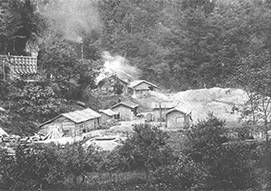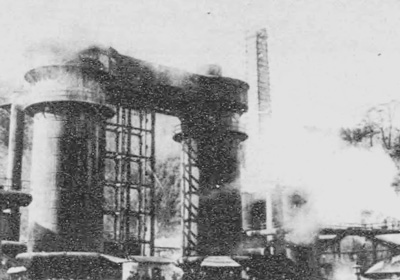Column <Tohoku>
5 Mining in Tohoku
The Tohoku region, which holds the Kitakami Mountains formed by complex geology and volcanic activity, has long been famous as a locale for a variety of mines. In the ancient Nara period, the account, "Mutsu Province has contributed the first gold in Japan", can be found in the Shoku Nihongi (Chronicles of Japan, continued).
The gold of Tohoku
It was the gold produced in Tohoku which supported the splendor of Hiraizumi, which was registered as a World Heritage. As the base of the Oshu Fujiwara family, Hiraizumi became the second biggest city in Japan following Kyoto in the Heian period, and featured many magnificent examples of Buddhist architecture. Of the buildings constructed by the Oshu Fujiwara family, the Chusonji Konjikido, with its roof, walls and pillars clad in gold, is said to have served as the basis for the image of the "golden country of Cipangu" described in Marco Polo's Toho Kenbunroku (Description of the world) as "the roof is clad with pure gold, and even the ornamental windows and other features are made of gold", and the building is still considered to be the symbol of the magnificent splendor of Hiraizumi today. It is said that the gold produced from the Tamayama gold mine located in the southeast of present-day Iwate-ken (Iwate Prefecture) was the main source of revenue for the Oshu Fujiwara family.
Gold continued to be produced in areas throughout Tohoku, with Kesennuma and Ofunato's "Date no Shikinzan" (4 gold mines of Date) (Yukisawa, Tamayama, Sakamotozawa, Imadeyama) supporting the finances of the Date family in the Edo period, and the Aizu Ishigamori gold mine serving as the main source of revenue for the Aizu clan. In addition to the Tamayama gold mine mentioned above, the Shishiori gold mine of Miyagi Prefecture was known of since the time of the most prosperous three generations of the Oshu Fujiwara family, continued to produce gold until it closed in the Showa era, and was an abundant resource with the "monster gold" of approximately 2.25 kg in weight and approximately 83% gold content being excavated in the Meiji era.
The silver and copper of Tohoku
In addition to gold, copper and silver were also produced in abundance in Tohoku. The Ani copper mine (Akita-ken (Akita Prefecture)) and the Innai silver mine (Akita-ken) each produced vast quantities of resources from the Edo period onward and were known as the great mines.
The Ani copper mine continued development into the mid-Edo period, and was a collective name for a total of 11 mines, of which just Ozawayama, which was eventually the central mine, alone was said to have produced 4,000-9,000 ko in its first year (1 ko = 16 kan, approximately equivalent to 240,000-540,000 kg). There are many legends regarding how the mine was discovered, including that a mysterious old trader appeared in a dream and told of the existence of the mine, or that a fox that had been living as a human told the human trader husband about the mine; however it appears that the actual beginning of the development was the accidental discovery of the mine by an itinerant trader from Osaka.
Innai silver mine was discovered slightly earlier than Ani copper mine, in the early Edo period, and it is said that the production amounts during the mine's development exceeded 5,000 kan per year (equivalent to 18,750 kg), and the population was said to have reached 15,000 people with the development of the silver mine, exceeding the population of the castle town of Akita, showing the prosperity of the time.
Moving forward in time, Kosaka mine (Akita-ken) was so prosperous that it was "said to be the greatest mine in Japan" (Kozan Hattatsushi) at the beginning of 1880. In the Meiji era, mining was carried out not by digging tunnels and excavating, but instead through large scale opencast mining, and it is said that the amount of earth excavated each day could even rival that of the Panama Canal which was under construction at the time. Thereafter, the output of Kosaka mine itself gradually decreased, but development continued as an independent refinery utilizing the large scale smelting facility constructed nearby and smelting technology to collect and refine the output from mines throughout Hokkaido and Tohoku. One can see the prosperity of the Kosaka mine at the time in the construction of the Kosaka mine office which was built in 1905. The office was a magnificent, Renaissance-style building that was designated as an Important Cultural Property in 2002.
However, the refining of the mine output also brought smoke pollution. At the Kosaka mine, the forest which was once adjacent to the mine withered, leaving the mountains bare, and the smoke also had a serious negative effect on nearby agricultural cultivation. In 1926, farmers unions demanded compensation for the damage caused by smoke from the operation of the mine, and clashes with security hired by the mine resulted in many farmers being injured. As a result of these clashes, it is said the mine installed a barbed wire fence through which 3,000 volts of electricity ran, and defended the blast furnace with nearly 200 armed guards from a military veterans organization and other sources, effectively putting the area around the mine under martial law.
The iron of Tohoku - Kamaishi mine and the iron industry
Iron was another of Tohoku's chief products, along with the precious gold, silver and copper.
Originally, the majority of the Kitakami mountains located in the center of the Tohoku region was known as an area from which iron sand could be extracted in great quantities as a result of the weathering of rocks, and in the Edo period, Tatarabuki (a unique Japanese steel manufacturing method where iron was extracted from iron sand using charcoal to produce iron) was introduced, greatly improving refining efficiency and resulting in iron becoming the chief product of the Sendai clan and the Nanbu clan.
Kamaishi mine in particular quickly adopted the western blast furnace method of refining from iron ore at the end of the Edo period, when most iron production in Japan still used iron sand, and became the Mecca of iron production. Oshima Takato, who worked hard to promote the introduction of blast furnaces at this time, is said to be the "father of modern Japanese iron manufacturing" and continued to be active as a leading authority in industrial arts even after the Meiji Restoration.
Kamaishi mine was characterized by its proximity to extremely high quality ore, and the ease with which the ore was able to be extracted in huge quantities through the relatively simple opencast mining method. In addition, the nearby forests also served as a source of the charcoal required to refine the iron. The granite required to construct the blast furnaces was also available nearby, and there was also running water nearby to serve as the source of hydraulic power to drive the blower equipment, allowing the mine to thrive in the iron refinement industry thanks to these and other advantages.
In the beginning of the Meiji era, the mine came to be directly operated by the Meiji government, along with Miike mine (Fukuoka-ken (Fukuoka Prefecture)), Ani mine (Akita-ken), and Innai mine (Akita-ken). During the period of government control, there were also periods of continuous losses, and the mine was eventually sold off to the private sector; however after being sold off, the latest type of British-style refining facility was built at the site, and it again began to be prosperous and was later developed into the Kamaishi ironworks.
Around 1900, the mine was reputed to "be the most prosperous iron mine currently in Japan" (Kozan Hattatsushi) and left its mark on modern Japanese steel and iron production history.
Reference
- Kozan Keisha Renmei (ed.), Kozan Rodo Undo Shi, Meiji, Taisho Hen, Sangyo Keizai Kenkyujo, 1947 【EL231-89】
- Kozan Hattatsushi, Noshomusho Kozankyoku, 1900 【86-169】
- Saeki Ariyoshi (ed.), Rikkoku Shi, vol.3-4, (Shoku Nihongi, vol.1-2), Asahi Shinbunsha, 1929 【594-14】
- Tatara Kenkyukai (ed.), Nihon Seitetsu Shi Ronshu, Tatara Kenkyukai, 1983 【DL366-69】
- Tsuda Masumi, "Meiji Zenki Kozangyo no Seikaku", Shakaigaku Kenkyu, vol.13, March 1974 【Z6-267】
- Miura Toyohiko, "Rodo Eiseigaku Shi Josetsu", Rodo Kagaku, vol.54(7), July 1978 【Z6-200】
- Mori Kahee, Mori Kahee Chosakushu, vol.3 (Michinoku Tetsu Sangyo no Kenkyu), Hosei Daigaku Syuppankyoku, 1994 【DC41-35】
- Watanabe Manjiro, Kozan Shiwa, Tohoku Hen, Rateisu, 1968 【569.212-W67k】


